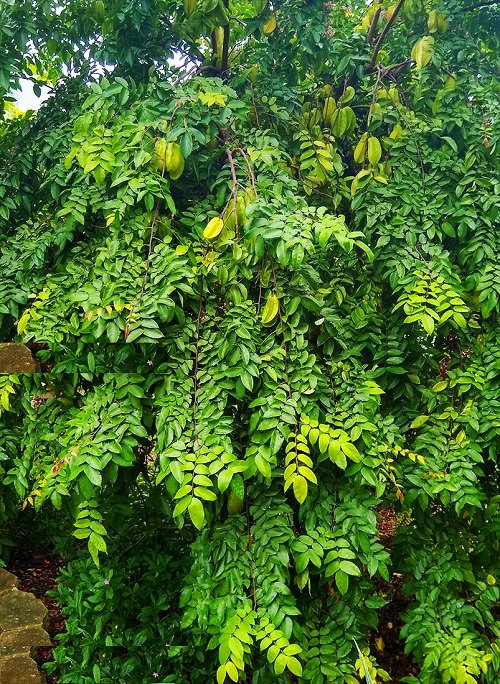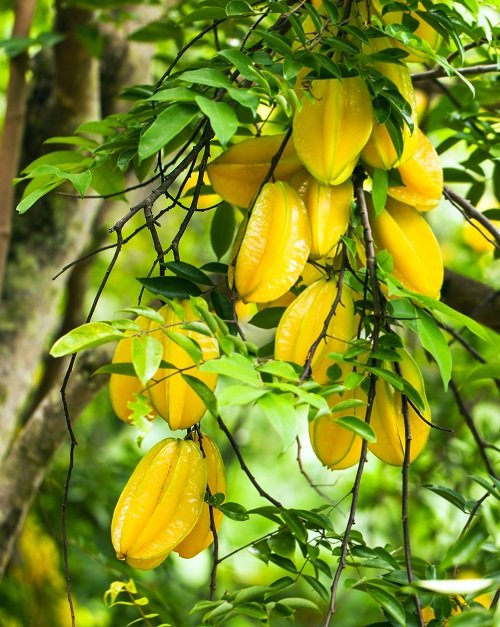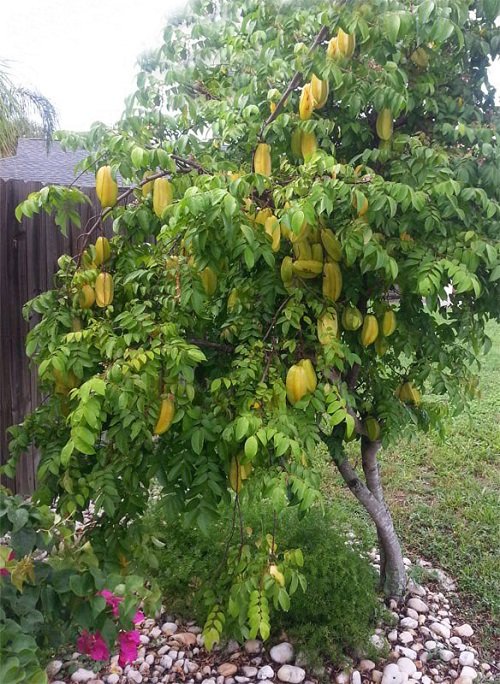Growing Carambola is easy if you mimic its ideal environment. Here’s everything you need to know about How to Grow Star Fruit!

Starfruit is a unique star-shaped fruit loved widely for its tarty juicy taste. If you want an unlimited supply, learn How to Grow Star Fruit at home!
Learn about Growing Star Anise here
Star Fruit Tree Information
Carambola is a slow-growing evergreen tree that grows 20-30 feet high. The tree features large leaves about 20 to 50 cm long and tarty star-shaped fruits. Not just fruits, but the star fruit tree flowers are attractive with rosy-pink shade directed toward the leaf axils or at the trunk or branch.
USDA Zones: 9-11
Botanical Name: Averrhoa carambola
Other Names: Foreign peach, Carambola, Five corners, Kamrakh, Karambal, Caturappuli, Yang Tao, and Kamranga
Do you Know about the Florida State Fruit? Learn here
Where does Starfruit Grow?
Carambola, also called star fruit, comes from Southeast Asian countries, parts of Sri Lanka, Indonesia, and Malaysia. However, it is cultivated majorly in subtropical and tropical areas, including Southern China, India, and the Philippines.
The tree prefers a warm tropical climate and cannot survive freezing temperatures. If you belong to the northern countries where temperatures dip below the freezing point, consider growing dwarf specimens of star fruit in containers or under a greenhouse to help it thrive.
Find How to Grow Dragon Fruits here
How to Grow Star Fruit?

Carambola needs warm soil to germinate, so Spring is the most suitable time if you are planning to grow starfruit from seeds. Do keep in mind that only the plump and fully developed seeds are viable for growth.
Sow the seeds in a well-draining peat-moss-based medium and place the pot where it gets ample bright indirect sunlight. Moisten the medium regularly. You’ll notice the seeds germinating in 7-10 days, which can then be transferred to a well-draining sunny spot in the garden.
Note: Starfruit plants can be planted directly on the ground if you have space and live in the subtropical and tropical regions (particularly in USDA Zones 9, 10, or 11) or in a pot below these zones.
Tip: Growing starfruits from seeds might not give you satisfactory results. Other options, such as inarching in India, shield-budding in the Philippines, and the Forkert method is applied in Java for successful propagation. It is wiser to get a well-grown tree from a nursery and tend it at your home under suitable conditions.
Check out the Most Exotic Fruits from Around the World here
When is Star Fruit Season?
The star fruit season differs according to the region. However, the main harvesting season is from late summer to early winter. In some areas of Florida, the fruit is available throughout the year, while some trees fruit during March and April. The varied climatic conditions are responsible for the difference in harvesting seasons.
Find out some Amazing Ways to Grow Tropical Fruits here
Star Fruit Tree Growing Requirements

Sunlight
Grow Carambolas in the sunniest location of your yard. It needs a minimum of 6-7 hours of direct sunlight to grow fruits. If growing in pots, make sure to rotate it to provide even distribution of sunlight. Prolonged exposure to shade will exhibit plant growth.
Temperature
Native to subtropical areas, star fruits cannot survive if exposed to negative temperatures. The ideal fruiting range is 68-85F or 20-30C. Exposing the plant to below 65F or 18C is the surest way to cease its growth.
Soil
Starfruit grows in various soil types but cannot stand water-logged medium. Make sure your garden is rich in humus and moderately acidic, with pH 5.5-6.5 for optimal growth.
If growing in pots, a blend of peat moss and sandy, loamy soil with a handful of perlite works best. You may also use a limestone-based medium to amend excess soil acidity.
Watering
The plant should be regularly watered when it’s young. Once established, water only when the soil is dry. Make sure not to overwater the plant, which might otherwise breed pests.
Check out the Fruits that Grow from Tops here
Star Fruit Tree Care
Fertilizing
Fertilize young starfruit with 10-10-10 fertilizer every month, except in winter. Mature trees should be fertilized at the beginning of the growing season. Additionally, you can apply compost or manure to improve the soil texture.
Pests and Diseases
Star fruit trees are prone to a number of pests, including carambola fruit flies, brown spots, Algal diseases, and even birds. Keep an eye on the younger plants and use a neem oil solution every month.
For older trees, you may need herbicides to get rid of the pests.
Learn about the Most Exotic Fruits that Grow on Cactus here
Harvesting Star Fruit
Harvesting star fruits is easy as they fall on their own once they are ripe. You may also pluck them manually and enjoy the juicy fruit.
Look at the Best Blue Fruits here
When Does Star Fruit Ripe?

After setting the fruits, they take 60-75 days to mature fully into ripe fruits. Its green-yellow fruit is about 12 cm long with 5 longitudinal ribs. While the tree can be quite prolific, you may need to wait 3-4 years to get an abundant harvest.
You Can Grow Fruits from Kitchen Leftovers Like this
How to Tell if Star Fruit is Ripe?
A ripe starfruit can be recognized by its yellow-orange flesh. The younger fruits are green in color and take a yellowish hue on ripening, while the ribs are flash in green. It is juicy and sweet and sour in taste and has a high content of oxalic acid, vitamins A and C.




just planted four year old seeds from a supermarket fruit in a sealed container containing damp potting compost. Result two seedlings (66% germination) now 11″ high. Should I nip the top out for a bush shape or grow a standard plant.
I live in the UK near the Yorkshire coast.
I would grow it as a standard initially then when it’s about a metre tall then pinch for branching out . It can get quite bushy and loaded with fruit. I have one that I have grown like that. It takes about 3 years to fruit.
(I know this question above is 3 years old, but my answer might be useful to someone else.)
I would grow it as a standard initially then when it’s about a metre tall, pinch for branching out . It can get quite bushy and loaded with fruit. I have one that I have grown like that. It takes about 3 years to fruit.
If planted in the ground place in loamy soil. Situate in plenty of sun and it can be grown near a wall or fence (south facing if possible). Though it’s an evergreen plant I would keep it in a pot and bubble wrap and protect with fleece the first few winters. If you do lose leaves, don’t panic, they will grow back (just give it some slow release winter food). Water regularly and fertilize in the spring and occasionally in the growing season. Mine did when it lost its leaves last winter and now its healthy and robust. (I know the question above is 3 years old, but my answer might be useful to someone else.) Hope this is useful to someone. I am based in Derbyshire.
Just a couple of amendments to my previous answer. Starfruit can be grown in partial shade, (morning and evening sun) they don’t like too much heat/direct mid day sun. If growing in a container, water thoroughly, but let the soil dry out in between watering, they don’t like wet feet (roots). Don’t fertilise in winter.
For overseas readers, Derbyshire is in the Peak District of the UK.
What are the storage conditions of carambola?
How many degrees is it stored?